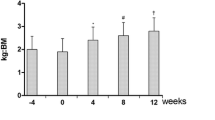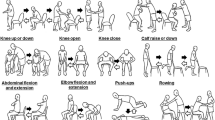Abstract
The present study compared the effects of 12 weeks of traditional resistance training and power training using rated perceived exertion (RPE) to determine training intensity on improvements in strength, muscle power, and ability to perform functional task in older women. Thirty healthy elderly women (60–75 years) were randomly assigned to traditional resistance training group (TRT; n = 15) or power training group (PT; n = 15). Participants trained twice a week for 12 weeks using six exercises. The training protocol was designed to ascertain that participants exercised at an RPE of 13–18 (on a 6–20 scale). Maximal dynamic strength, muscle power, and functional performance of lower limb muscles were assessed. Maximal dynamic strength muscle strength leg press (≈58 %) and knee extension (≈20 %) increased significantly (p < 0.001) and similarly in both groups after training. Muscle power also increased with training (≈27 %; p < 0.05), with no difference between groups. Both groups also improved their functional performance after training period (≈13 %; p < 0.001), with no difference between groups. The present study showed that TRT and PT using RPE scale to control intensity were significantly and similarly effective in improving maximal strength, muscle power, and functional performance of lower limbs in elderly women.


Similar content being viewed by others
References
Aagaard P, Suetta C, Caserotti P, Magnusson SP, Kjaer M (2010) Role of the nervous system in sarcopenia and muscle atrophy with aging: strength training as a countermeasure. Scand J Med Sci Sports 20:49–64. doi:10.1111/j.1600-0838.2009.01084.x
Adams KJ, Swank AM, Barnard KL, Berning JM, Sevene-Adams PG (2000) Safety of maximal power, strength, and endurance testing in older African American women. J Strength Cond Res 14:254–260
Berger MJ, Doherty TJ (2010) Sarcopenia: prevalence, mechanisms, and functional consequences. Interdiscip Top Gerontol 37:94–114. doi:10.1159/000319997
Borg G (1970) Perceived exertion as an indicator of somatic stress. Scand J Rehabil Med 2:92–98
Bosco C, Komi PV, Tihanyi J, Fekete G, Apor P (1983) Mechanical power test and fiber composition of human leg extensor muscles. Eur J Appl Physiol Occup Physiol 51:129–135
Cadore EL et al. (2011) Neuromuscular economy, strength, and endurance in healthy elderly men. J Strength Cond Res 25:997–1003. doi:10.1519/JSC.0b013e3181d650ba
Cadore EL et al. (2012) Strength prior to endurance intra-session exercise sequence optimizes neuromuscular and cardiovascular gains in elderly men. Exp Gerontol 47:164–169. doi:10.1016/j.exger.2011.11.013
Correa CS et al. (2012) 3 different types of strength training in older women. Int J Sports Med 33:962–969. doi:10.1055/s-0032-1312648
De Vos NJ, Singh NA, Ross DA, Stavrinos TM, Orr R, Singh MAF (2005) Optimal load for increasing muscle power during explosive resistance training in older adults. J Gerontol A Biol Sci Med Sci 60:638–647
Earles DR, Judge JO, Gunnarsson OT (2001) Velocity training induces power-specific adaptations in highly functioning older adults. Arch Phys Med Rehabil 82:872–878. doi:10.1053/apmr.2001.23838
Fielding RA, LeBrasseur NK, Cuoco A, Bean J, Mizer K, Fiatarone Singh MA (2002a) High-velocity resistance training increases skeletal muscle peak power in older women. J Am Geriatr Soc 50:655–662
Fielding RA, LeBrasseur NK, Cuoco A, Bean J, Mizer K, Fiatarone Singh MA (2002b) High-velocity resistance training increases skeletal muscle peak power in older women. J Am Geriatr Soc 50:655–662. doi:10.1046/j.1532-5415.2002.50159.x
Focht BC (2007) Perceived exertion and training load during self-selected and imposed-intensity resistance exercise in untrained women. J Strength Cond Res 21:183–187
Folland JP, Buckthorpe MW, Hannah R (2014) Human capacity for explosive force production: neural and contractile determinants. Scand J Med Sci Sports 24:894–906. doi:10.1111/sms.12131
Gearhart RF, Goss FL, Lagally KM, Jakicic JM, Gallagher J, Robertson RJ (2001) Standardized scaling procedures for rating perceived exertion during resistance exercise. J Strength Cond Res 15:320–325
Gearhart RF Jr, Goss FL, Lagally KM, Jakicic JM, Gallagher J, Gallagher KI, Robertson RJ (2002) Ratings of perceived exertion in active muscle during high-intensity and low-intensity resistance exercise. J Strength Cond Res/Natl Strength Cond Assoc 16:87–91
Glass SC, Stanton DR (2004) Self-selected resistance training intensity in novice weightlifters. J Strength Cond Res 18:324–327
Hakkinen K, Pakarinen A, Kraemer WJ, Hakkinen A, Valkeinen H, Alen M (2001) Selective muscle hypertrophy, changes in EMG and force, and serum hormones during strength training in older women. J Appl Physiol 91:569–580
Hazell T, Kenno K, Jakobi J (2007) Functional benefit of power training for older adults. J Aging Phys Act 15:349–359
Henwood TR, Taaffe DR (2006) Short-term resistance training and the older adult: the effect of varied programmes for the enhancement of muscle strength and functional performance. Clin Physiol Funct Imaging 26:305–313. doi:10.1111/j.1475-097X.2006.00695.x
Henwood TR, Riek S, Taaffe DR (2008) Strength versus muscle power-specific resistance training in community-dwelling older adults. J Gerontol Series A, Biol Sci Med Sci 63:83–91
Izquierdo M, Aguado X, Gonzalez R, Lopez JL, Hakkinen K (1999) Maximal and explosive force production capacity and balance performance in men of different ages. Eur J Appl Physiol Occup Physiol 79:260–267. doi:10.1007/s004210050504
Kleiner DM, Blessing DL, Mitchell JW, Davis WR (1999) A description of the acute cardiovascular responses to isokinetic resistance at three different speeds. J Strength Cond Res 13:360–366
Lagally KM, Robertson RJ, Gallagher KI, Gearhart R, Goss FL (2002a) Ratings of perceived exertion during low- and high-intensity resistance exercise by young adults. Percept Mot Skills 94:723–731. doi:10.2466/pms.2002.94.3.723
Lagally KM, Robertson RJ, Gallagher KI, Gearhart R, FL G (2002b) Ratings of perceived exertion during low- and high-intensity resistance exercise by young adults. Percept Mot Skills 94:723–731
Latham NK, Bennett DA, Stretton CM, Anderson CS (2004) Systematic review of progressive resistance strength training in older adults. J Gerontol A Biol Sci Med Sci 59:48–61
Macaluso A, De Vito G (2004) Muscle strength, power and adaptations to resistance training in older people. Eur J Appl Physiol 91:450–472. doi:10.1007/s00421-003-0991-3
Metter EJ, Conwit R, Tobin J, Fozard JL (1997) Age-associated loss of power and strength in the upper extremities in women and men. J Gerontol Series A, Biol Sci Med Sci 52:B267–B276
Miszko TA, Cress ME, Slade JM, Covey CJ, Agrawal SK, Doerr CE (2003a) Effect of strength and power training on physical function in community-dwelling older adults. J Gerontol Series A, Biol Sci Med Sci 58:171–175
Miszko TA, Cress ME, Slade JM, Covey CJ, Agrawal SK, Doerr CE (2003b) Effect of strength and power training on physical function in community-dwelling older adults. J Geront-Serie Biol Sci Med Sci 58:171–175
Mitchell CJ, Churchward-Venne TA, West DW, Burd NA, Breen L, Baker SK, Phillips SM (2012) Resistance exercise load does not determine training-mediated hypertrophic gains in young men. J Appl Physiol 113:71–77. doi:10.1152/japplphysiol.00307.2012
Mosallanezhad Z, Salavati M, Sotoudeh GR, Nilsson Wikmar L, Frandin K (2014) Walking habits and health-related factors in 75-year-old Iranian women and men. Arch Gerontol Geriatr 58:320–326. doi:10.1016/j.archger.2013.11.008
Nelson ME, Fiatarone MA, Morganti CM, Trice I, Greenberg RA, Evans WJ (1994) Effects of high-intensity strength training on multiple risk factors for osteoporotic fractures. A randomized controlled trial. JAMA 272:1909–1914
Nogueira W, Gentil P, Mello SN, Oliveira RJ, Bezerra AJ, Bottaro M (2009) Effects of power training on muscle thickness of older men. Int J Sports Med 30:200–204. doi:10.1055/s-0028-1104584
Perri MG, Anton SD, Durning PE, Ketterson TU, Sydeman SJ, Berlant NE, Kanasky WF Jr, Newton RL Jr, Limacher MC, Martin AD (2002) Adherence to exercise prescriptions: Effects of prescribing moderate versus higher levels of intensity and frequency. Health Psychol 21:452–458
Pijnappels M, van der Burg PJ, Reeves ND, van Dieen JH (2008) Identification of elderly fallers by muscle strength measures. Eur J Appl Physiol 102:585–592. doi:10.1007/s00421-007-0613-6
Porter MM (2006) Power training for older adults applied physiology, nutrition, and metabolism. Physiol Appl, Nutr Et Metab 31:87–94. doi:10.1139/h05-034
Rabelo HT, Oliveira RJ, Bottaro M (2004) Effects of resistance training on activities of daily living in older women. Biol Sport 21:325–336
Ramirez-Campillo R et al. (2014a) High-speed resistance training is more effective than low-speed resistance training to increase functional capacity and muscle performance in older women. Exp Gerontol 58C:51–57. doi:10.1016/j.exger.2014.07.001
Ramirez-Campillo R et al. (2014b) High-speed resistance training is more effective than low-speed resistance training to increase functional capacity and muscle performance in older women. Exp Gerontol 58:51–57. doi:10.1016/j.exger.2014.07.001
Rice J, Keogh JWL (2009) Power training: can it improve functional perfomance in older adults? A systematic review. Int J Exerc Sci 2:131–151
Robertson RJ, Noble BJ (1997) Perception of physical exertion: methods, mediators, and applications. Exerc Sport Sci Rev 25:407–452
Row BS, Knutzen KM, Skogsberg NJ (2012) Regulating explosive resistance training intensity using the rating of perceived exertion. J Strength Cond Res/Natl Strength Cond Assoc 26:664–671. doi:10.1519/JSC.0b013e31822ac367
Sanborn K et al. (2000) Short-term performance effects of weight training with multiple sets not to failure vs. a single set to failure in women. J Strength Cond Res 14:328–331
Scott BR, Duthie GM, Thornton HR, Dascombe BJ (2016) Training monitoring for resistance exercise: theory and applications. Sports Med. doi:10.1007/s40279-015-0454-0
Seynnes O, Singh MAF, Hue O, Pras P, Legros P, Bernard PL (2004) Physiological and functional responses to low-moderate versus high-intensity progressive resistance training in frail elders. J Gerontol A Biol Sci Med Sci 59:503–509
Siegel JA, Gilders RM, Staron RS, Hagerman FC (2002) Human muscle power output during upper- and lower-body exercises. J Strength Cond Res/Natl Strength Cond Assoc 16:173–178
Steib S, Schoene D, Pfeifer K (2010) Dose-response relationship of resistance training in older adults: a meta-analysis. Med Sci Sports Exerc 42:902–914. doi:10.1249/MSS.0b013e3181c34465
Straight CR, Lindheimer JB, Brady AO, Dishman RK, Evans EM (2015) Effects of resistance training on lower-extremity muscle power in middle-aged and older adults: a systematic review and meta-analysis of randomized controlled trials. Sports Med. doi:10.1007/s40279-015-0418-4
Suzuki T, Bean JF, Fielding RA (2001) Muscle power of the ankle flexors predicts functional performance in community-dwelling older women. J Am Geriatr Soc 49:1161–1167
Sweet TW, Foster C, McGuigan MR, Brice G (2004) Quantitation of resistance training using the session rating of perceived exertion method. J Strength Cond Res 18:796–802
Thompson BJ, Conchola EC, Palmer TB, Stock MS (2014) Effects of aging on maximal and rapid velocity capacities of the leg extensors. Exp Gerontol 58C:128–131. doi:10.1016/j.exger.2014.07.019
Tiggemann CL, Korzenowski AL, Brentano MA, Tartaruga MP, Alberton CL, Kruel LF (2010) Perceived exertion in different strength exercise loads in sedentary, active, and trained adults. J Strength Cond Res 24:2032–2041. doi:10.1519/JSC.0b013e3181d32e29
Tschopp M, Sattelmayer MK, Hilfiker R (2011) Is power training or conventional resistance training better for function in elderly persons? A meta-analysis. Age Ageing 40:549–556. doi:10.1093/ageing/afr005
Verbrugge LM, Jette AM (1994) The disablement process. Soc Sci Med 38:1–14
Wallerstein LF et al. (2012) Effects of strength and power training on neuromuscular variables in older adults. J Aging Phys Act 20:171–185
Young A, Skelton DA (1994) Applied physiology of strength and power in old age. Int J Sports Med 15:149–151. doi:10.1055/s-2007-1021037
Author information
Authors and Affiliations
Corresponding author
Ethics declarations
Subjects gave their written informed consent to participate. The institutional research ethics committee approved all procedures of the present study
About this article
Cite this article
Tiggemann, C.L., Dias, C.P., Radaelli, R. et al. Effect of traditional resistance and power training using rated perceived exertion for enhancement of muscle strength, power, and functional performance. AGE 38, 42 (2016). https://doi.org/10.1007/s11357-016-9904-3
Received:
Accepted:
Published:
DOI: https://doi.org/10.1007/s11357-016-9904-3




